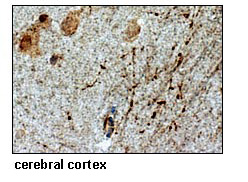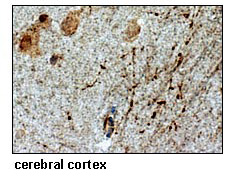Anti-SLC6A4 (SERT) (Human) pAb
| Code | Size | Price |
|---|
| MBL-BMP045 | 50 ul | £323.00 |
Quantity:
Prices exclude any Taxes / VAT
Overview
Host Type: Rabbit
Antibody Isotype: IgG
Antibody Clonality: Polyclonal
Regulatory Status: RUO
Target Species: Human
Applications:
- Immunohistochemistry (IHC)
- Western Blot (WB)
Shipping:
4°C
Storage:
-20°C
Images
Documents
Further Information
Applications:
WB - 1:1000 (chemiluminescence detection system) IHC - 1:5000 (Heat treatment required for paraffin)
Background:
SLC6A4, also known as a serotonin
transporter (SERT), belongs to the Na
+
- and Cl
?
-dependent neurotransmitter transporter family and
transports the neurotransmitter serotonin from synaptic
spaces into presynaptic neuron
s. This activity of SLC6A4
terminates the synaptic actions of serotonin, and the
presynaptic neurons release it once again into the
neurotransmitter pool. A repeat length polymorphism in the
SLC6A4
gene promoter has been shown to affect the rate of
serotonin uptake and may thus be associated with the
sudden infant death syndrome, aggressive behavior in
Alzheimer disease patients, and the susceptibility of people
experiencing emotional trauma to depression.
Formulation:
50 ul volume of PBS containing50% glycerol, pH 7.2. No preservative is contained.
Gene IDs:
Human: 6532 Mouse: 15567
Immunogen Translated:
Synthetic peptide derived from human SLC6A4
Reactivity:
This antibody can be used to stain
endogenous antigen in paraffin embedded human tissues
including cerebral cortex by Immunohistochemistry. The
reactivity has been confirmed by Western blotting to detect
the full length of human SLC6A4 transiently expressed in
HEK 293T cells.
Shelf Life:
1 year
Source:
This antibody was affinity purified from rabbit
serum. The rabbit was immunized with a synthetic peptide
derived from human SLC6A4
Target:
SLC6A4/SERT
References
?1) Lesch, K. P., et al., Science 274, 1527-1530 (1996)
2) Ramamoorthy, S., et al., PNAS 90, 2542-2546 (1993)






